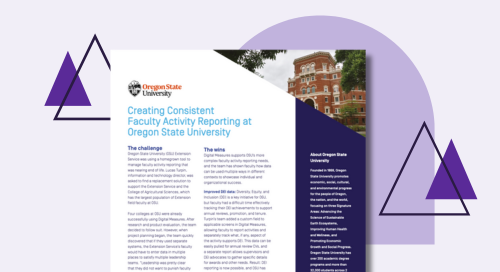Oregon State University (OSU) Extension Service was using a homegrown tool to manage faculty activity reporting that was nearing end of life. Lucas Turpin, information and technology director, was asked to find a replacement solution to support the Extension Service and the College of Agricultural Sciences, which has the largest population of Extension field faculty at OSU.
Four colleges at OSU were already successfully using Digital Measures. After research and product evaluation, the team decided to follow suit. However, when project planning began, the team quickly discovered that if they used separate systems, the Extension Service’s faculty would have to enter data in multiple places to satisfy multiple leadership teams. “Leadership was pretty clear that they did not want to punish faculty by having them do double data entry into two different systems,” Turpin said. “They were really looking for a unified system that would work well for both the Extension Service and the whole College of Agricultural Sciences.”


OSU strategically configured a new, multi-tenant system within Digital Measures to serve both the Extension Service and the College of Agricultural Sciences. This approach can accommodate other colleges within the institution as they move to Digital Measures for faculty activity reporting.
Diversity, Equity, and Inclusion (DEI) is a key initiative for OSU, but faculty had a difficult time effectively tracking their DEI achievements to support annual reviews, promotion, and tenure. Turpin’s team added a custom field to applicable screens in Digital Measures, allowing faculty to report activities and separately track what, if any, aspect of the activity supports DEI. This data can be easily pulled for annual review CVs, and a separate report allows supervisors and DEI advocates to gather specific details for awards and other needs. Result: DEI reporting is now possible, and OSU has seen a nearly 4% annual increase across all five units, with a 5% increase in DEI reporting for the Extension Service.
The team vowed to reuse Digital Measures data as much as possible, and encouraged staff to search the system before asking faculty members for information or metrics. As a result, the OSU IT team has seen an uptick in reporting requests as leadership turns to Digital Measures for information rather than asking faculty for it.
To foster goodwill among faculty and leadership, Turpin and his team react quickly to requests and respond positively to feedback and enhancement suggestions. After the team produces a report, they review the data sources that were used to build it and send a note to each person whose information was included, thanking them for keeping their records up to date. This simple practice builds positive word-of-mouth and community support for the system while encouraging faculty to ensure their accomplishments are included in future reports.
Digital Measures has allowed OSU to take a flexible approach to web profiles, with different methods for different areas of the institution. Faculty in the College of Agricultural Sciences use an opt-in model that allows them to display the publications and awards they choose from their Digital Measures data. The Extension Service’s web profiles use a more automated approach. If publication and/or award data is available in Digital Measures, it is automatically pulled into tabs on the web profile, and if not, those tabs are hidden. This module has also simplified faculty web profile management by reducing the need for double entry of publications.
We’ve centralized all the data into Digital Measures, and there are different ways to slice and dice the information and leverage it centrally. We can share the best of what we do.”
Lucas Turpin, Information and Technology Director, Oregon State University
The OSU Extension Service uses Digital Measures to drive its annual federal reporting efforts and track information specific to land grant institutions. The system includes two custom screens that track impact statements and civil rights demographics information. This information is also used for program and local county impact reporting, in external communications, and to drive improvements to programming and engagement. “We’ve centralized all the data into Digital Measures, and there are different ways to slice and dice the information and leverage it centrally,” Turpin said. “We can share the best of what we do.”
OSU continues to develop new reports and find new ways to leverage the information captured within Digital Measures, as leadership begins to see the value of the data coming from the system. “They’ve seen the quality of the reports that we’re able to generate and they’re starting to ask more questions: How did you do this? What else can you give us? What if we could do this for everyone else?” Turpin said. “It’s sparking greater interest across the institution, and we’re scaled and ready to go if the university wants to expand.”
The team is planning to compare data from the publication Oregon By the Numbers to Digital Measures data to see how the university’s program delivery and demographics data compares to the actual demographics of Oregon counties. This will allow them to identify gaps in OSU’s programming compared to the actual population, fine-tune programming, and increase engagement.

See how our tools are helping clients right now, get in-depth information on topics that matter, and stay up-to-date on trends in higher ed.